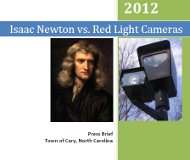4/30/2012
Opinion: When a Yellow Light is Too LongIncreasing yellow times beyond 6 seconds is going too far.

Opponents of red light cameras argue that the primary reason vehicles run red lights is that yellow signal times are too short. By this, they mean drivers who come upon a light that has just changed from green to yellow do not have enough time either to comfortably come to a stop or proceed through to the other side of the intersection before the signal begins displaying a steady red. Some have taken the concept of "longer yellows" as a remedy for the problem to the extreme.
Responsible organizations like the National Motorists Association advocate a modest boost in yellow time as part of a suite of engineering improvements rendering photo ticketing entirely unnecessary (view alternatives). Others are actively promoting yellow intervals that range from a low of 4.8 seconds at 25 MPH to a high of 10.0 seconds at 65 -- far beyond the 6-second maximum allowed under federal regulations. The longer figures are said to be absolutely correct and required.
"The equation embeds Newton's Laws of Motion," Brian Ceccarelli wrote on his Red Light Robber website. "Therefore by the laws of the universe, no yellow light duration can be set less than these values. If less, then the yellow duration is illegal by the Canute Rule."
Short yellows are a serious problem. In 2001, the Office of the US House Majority Leader issued a report, "The Red Light Running Crisis: Is it Intentional?" explaining in detail the changes the Institute of Transportation Engineers (ITE) made to the commonly used yellow timing formula between 1976 and 1999 (view signal timing chapter). Engineers manipulated the standard equation so that it produced yellow times generally shorter by around a second so that, according to the ITE, "enforcement can be used instead" of longer yellows. Prior to the arrival of photo enforcement at intersections, engineers were told to use the equation as a starting point, lengthening the timing until the desired result was achieved.
"When the percent of vehicles that are last through the intersection which enter on red exceeds that which is locally acceptable (many agencies use a value of one to three percent), the yellow interval should be lengthened until the percentage conforms to local standards," the ITE wrote in its 1985 recommended practice (read report in PDF).
This practice reflects the proper understanding of traffic engineering. The daily interplay at a given intersection of tens of thousands of drivers varying widely in age and ability driving anything from lightweight sports cars with impressive braking ability to heavily laden 18-wheelers cannot be captured by a mathematical equation. Visibility at the intersections also varies between night and day and pavement conditions can change with the weather. The ITE equation attempts to get the engineer in the ballpark of the best value by producing a recommended minimum, and it is his duty to ensure the theoretical timing is appropriate in practice. The equation is the starting point, not the end point.
The ITE had it right with the formula published in 1976, adjusted to suit actual intersection conditions. Both the states of Georgia and Ohio have enacted laws mandating an across-the-board one second increase in yellow times at red light camera intersections. This was a crude way of correcting the current ITE formula so that photo enforced intersections would have signal timing close to what they would have had decades ago.
The results in practice speak for themselves. After the one second law took effect, violations in Georgia dropped to such a low level that Lasercraft, the state's primary photo enforcement company at the time, essentially went out of business and was acquired by a competitor. TheNewspaper reviewed the before and after results after obtaining documents from every red light camera program in the state. Straight through signal violations are a non-issue, leaving a handful of locations that survive on ticketing for rolling right-turns on red. Likewise, in Fairfax County, Virginia, the data show a signal lengthened from 4.0 to 5.5 seconds cut violations by over 90 percent (view data), resulting in less than one percent of daily traffic violating the red. Nothing would be gained by further increasing the yellow. These real-world results are the only thing that matters.
A yellow should only be as long as it needs to be to achieve compliance, in actual practice, with the ultimate goal of reducing the number of accidents to an absolute minimum. There is no benefit in further lengthening yellows simply to satisfy a theoretical assumption.


